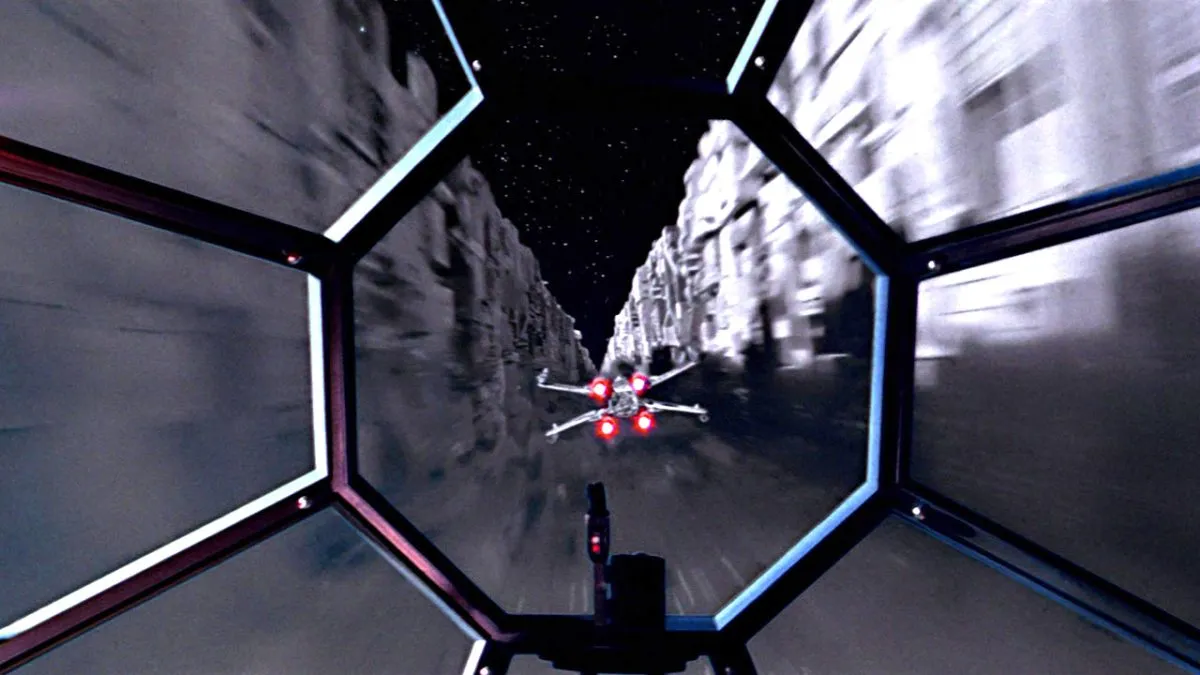The highly dramatic ending to the original Star Wars film was almost not to be, thanks to executives at 20th Century Fox Studios.
In episode 2 of the Disney Plus series Light & Magic — which showcases the early days of the special effects company Industrial Light & Magic created by George Lucas — one editor on the original film sheds some light on the constantly changing ending to the movie.
First, it’s worth noting that when Lucas, who didn’t even know what a filmmaker was until he went to college, began making the initial film, he was obviously uncertain if it would be successful and thus he was unsure if he would be allowed to make the next two films in order to complete the trilogy. So, he decided to take the end of the trilogy — which is the destruction of the Death Star — and make it the end of the first film so that he at least had a conclusive story. This is why Return of the Jedi also ends with the destruction of a new Death Star, though it’s disappointing that Lucas didn’t come up with a fresh original idea dissimilar to the ending of the original film.
However, while filming, Fox Studio executives began to worry about the budget, a worry that was compounded by the numerous issues experienced throughout filming, including constant breakdown of equipment, sandstorms on location in Tunisia, and the British crew that was — by many accounts — fairly unhelpful and rather disliked the film, so they refused to stay a minute longer than needed at end of business day, though union rules supported their daily decision.
As the Star Wars film exceeded budget, one particular exec — Alan Ladd, Jr. — defended Lucas and the film. Ladd constantly fought for more time for Lucas and was mostly able to get it but other execs were losing patience and decided that there was no need for the film’s Death Star finale.
Why? Well, one of the editors on the film, Paul Hirsch, explained:
“The end battle was of particular importance to George because the studio was threatening to eliminate it. They had concerns about cost overruns and they thought, ‘Hey, they get to the Death Star, they rescue the princess, that’s it. Story’s over.’ But George was determined to have this end battle.”
The studio clearly wasn’t focused on the better ending because it cost more money and most of them had lost hope in the film being anywhere near successful anyway. However, Lucas may have unintentionally influenced the studio when you consider that this original ending was also without the Death Star finale.
Despite the studio’s desire to wrap the film, Lucas pushed through and was able to finish the Death Star battle scenes just in time before the studio gave a definitive deadline.
However, there was another twist.
The original version of the ending was missing a key element. Of course, it had a great space battle concluding with Luke Skywalker blowing up the Death Star, but it did not have any threat from the Death Star itself. There was no countdown for when the Death Star would be in firing range to destroy Yavin IV, which is the moon where the rebels were hiding, because this highly dramatic aspect of the ending had not yet dawned on Lucas.
As the Star Wars creator himself explains, “It wasn’t until the post-production process when we came up with the idea that if they didn’t blow up the Death Star then the Death Star would blow up them.”
With filming already completed and Lucas realizing that this was a hugely important addition, he turned to the editors to create some magic.
Lucas explained, “The countdown to the Death Star came out of editing. It wasn’t in the script but as we started to edit the film, I came up with the idea of the Death Star bearing down on the planet.”
Hence, when you see the Death Star preparing to fire, it’s just the same scene as when it fired upon the planet of Alderaan earlier in the film. The editors, including Paul Hirsch and Richard Chew, extracted the audio of actor Peter Cushing — who plays Grand Moff Tarkin — saying “You may fire when ready,” from that Alderaan scene and applied it to the Death Star ending scene, albeit with a faraway shot of Tarkin also from earlier in the film.
Thus, instead of Star Wars ending with the rescue of Princess Leia, we were gifted with the battle in the trenches of the Death Star. Also, instead of just the battle, we were gifted with the Death Star about to destroy the rebel moon.
Certainly, the version we got is better than what we would have seen if Lucas didn’t add both of those elements to the film’s ending.











Published: Oct 10, 2023 03:42 pm